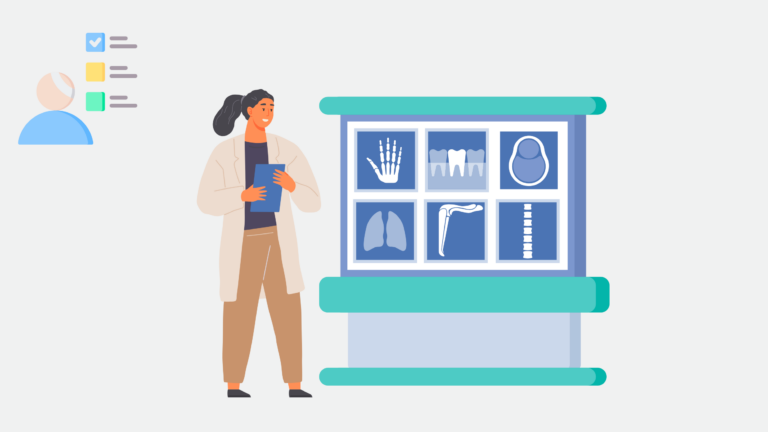
Le processus actuel de triage pour l'imagerie médicale à Vancouver Coastal Health (VCH) et dans les hôpitaux à travers le pays est chronophage et incohérent, nécessitant que le personnel de santé priorise manuellement chaque demande d'imagerie en fonction des informations fournies par le prestataire de soins par rapport aux directives nationales et provinciales. La disponibilité et l'application limitées des données récentes, pertinentes et historiques des patients posent des défis pour une prise de décision et une priorisation cohérentes. Cela entraîne des retards, en particulier pour les cas urgents, et affecte l'accès équitable des patients aux services d'imagerie.
La solution idéale tirerait parti de l'apprentissage automatique (ML), de l'intelligence artificielle (IA) et du traitement du langage naturel (NLP) pour automatiser le processus de triage en imagerie médicale pour l'IRM, le CT et l'échographie. Rationaliser ce travail de triage réduira les charges administratives du personnel d'imagerie médicale et des radiologistes, améliorera la cohérence de la priorisation et augmentera l'accès aux services d'imagerie.
Vancouver Coastal Health publie cet appel à l'innovation pour rechercher des entreprises canadiennes qualifiées capables de répondre aux résultats souhaités suivants. VCH et CAN Health se réservent le droit de ne pas poursuivre ce projet à leur entière discrétion, notamment s'il n'existe aucune entreprise canadienne qualifiée capable de répondre raisonnablement aux résultats souhaités.
Pour être éligible à un projet du Réseau de Santé CAN, l'entreprise doit répondre TOUS les critères suivants :
- Siège social au Canada (des critères supplémentaires s'appliquent pour les entreprises dont le siège social n'est pas au Canada)
- Propriété majoritaire de l'entreprise et de la solution par des Canadiens
- Solution à un niveau de maturité technologique (TRL) >7, indiquant une technologie réelle complétée et qualifiée par des tests et des démonstrations
- Toutes les données et les modèles d'IA (le cas échéant) doivent être hébergés au Canada et se conformer à toutes les réglementations canadiennes en matière de confidentialité
- Posséder toutes les approbations réglementaires nécessaires pour la commercialisation, incluant l'approbation de Santé Canada, si nécessaire
- Avoir complété toutes les études cliniques nécessaires sur la validité/uniformité
- Pas besoin de changements de politique pour adopter et implémenter la solution
- Strong use cases in the Canadian healthcare system.
Si l'entreprise n'a pas son siège social au Canada ou si la solution n'est pas majoritairement détenue par des Canadiens, des critères supplémentaires s'appliquent :
- Autonomie indépendante sur les opérations commerciales et le développement de produits (pour les filiales, les affiliés ou les distributeurs)
- Potentiel élevé de création d'emplois au Canada, en particulier dans les postes exécutifs et de haute direction
- Commitment of over 70% of contract value to Canada.
Lors du processus de sélection des entreprises, la préférence est donnée aux entreprises/solutions entièrement détenues par des Canadiens, suivies par celles majoritairement détenues par des Canadiens, et enfin les entreprises internationales ayant une présence significative et un impact économique au Canada.
Pour obtenir plus de renseignements sur le processus d’appel à l’innovation et les projets de commercialisation financés par le Réseau de santé CAN, veuillez consulter la page FAQ du site Web du Réseau de santé CAN : https://canhealthnetwork.ca/faq/
Énoncé du problème:
The current triaging process for medical imaging is time-consuming and
inconsistent, requiring healthcare staff to manually prioritize requests for
imaging against on National and Provincial guidelines. Limited availability and
application of recent, relevant, and historical patient data poses challenges in
consistent decision-making and prioritization. This leads to delays, particularly
for urgent cases, and impacts equitable patient access to imaging services.
Objectifs:
The goal is to identify AI-driven solutions that leverage ML and NLP to
automate the triaging of Medical Imaging requisitions for US. The proposed
solution aims to:
● Streamline triaging workflows by automating the review and
prioritization of imaging requisitions.
● Utilize patient data from provincial archives to support clinical
decision-making for appropriateness and prioritization.
● Apply AI algorithms to predict imaging needs, including priority level,
contrast requirements, protocol, and exam duration.
● Enhance patient access by matching requisitions with the imaging
sites offering the shortest wait times in their geographic region.
● Ensure a consistent, unbiased prioritization process aligned with
national and provincial guidelines.
Résultats Essentiels (Obligatoires) :
● Increased Efficiency: By automating triaging, the solution will reduce
the administrative burden, shorten triage turnaround times, and
increase capacity.
● Consistent Prioritization: AI-driven predictions will ensure uniform
application of prioritization guidelines, eliminating inconsistencies
across sites and imaging modalities and supporting more equitable
patient access.
The timeline needed to train a single modality model is estimated at 12
mois
● Reduced Wait Times: By enhancing the speed and accuracy of
triaging, urgent imaging requests will be addressed more quickly,
reducing overall wait times and increasing the percentage of exams
completed within wait time benchmarks.
● Optimized Resource Utilization: The solution will support waitlist
management by utilizing AI to match patients to imaging sites with
available capacity.
● Continuous feedback loop: Health Authorities will introduce a
Continuous Quality Improvement framework to improve the solution’s
accuracy and enhance its triaging capabilities.
● Scalability: The solution has the potential to be utilized outside of
Medical Imaging and expand to other units such as Cardiology,
Molecular Imaging, etc.
Within the Lower Mainland of British Columbia, over 640,000 requisitions for
MRI, CT, and US are triaged annually, with this number rising to 1,530,000
requisitions provincially and approximately 7,000,000 nationally, excluding
Quebec. The manual triaging process, while critical for determining imaging
priorities, is time-consuming and prone to variability, which can delay urgent
exams and create inequitable access to care. Human resource constraints,
coupled with increasing demand from an aging population, further strain the
healthcare system, making the automation of triaging processes an urgent
need.
The use of Artificial Intelligence (AI) and Natural Language Processing (NLP) to
assist with triaging imaging requests will benefit the patient and medical care
providers by reducing repetitive and low-value work, increasing the speed of
triaging, and ensuring introduction of a non-biased process of determining the
priority of a study.
Human Resource limitations are an important source of inefficiency, reducing
capacity in the medical system. Freeing physicians, technologists, and clerical
staff from automatable and low-value activities will translate into improved
capacity and access.
The requisition content and past patient history, if available and applicable,
can be used to produce an unbiased prioritization score that is consistent with
the applicable prioritization guideline(s). Patients and providers can trust that
their need for imaging is being treated with fairness and consistency. This
data driven approach will facilitate a better understanding of the service
delivery demands of the population and enable MI to better identify, predict
and respond to evolving trends in imaging ordering practices.
Timely triaging practices will also shorten turnaround times, creating more
time to schedule and complete exams within wait time benchmarks, especially
urgent exams with targets of 7 days or less.
A three-phase approach is recommended to realize a commercially viable
product.
1. Minimally viable solution used for wait list management – predicting
priority only for one imaging modality (US)
2. Viability – Suggesting Appropriateness, Priority, Protocol, need for
contrast enhanced imaging and exam duration (US)
3. If successful, proceed to automated prioritization, supported by a
robust, in-house, quality assurance program.

